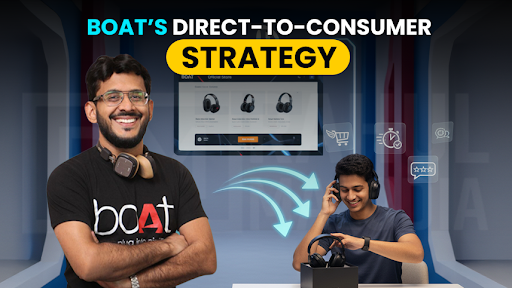
What Small Businesses Can Learn from Boat’s Direct-to-Consumer Strategy
The Beginning of a New Wave in Indian Business
There was a time when Indian entrepreneurs believed that only big brands with deep pockets could dominate markets. Advertising on television, paying distributors, and building retail networks seemed like the only way to scale. Small businesses often accepted that growth meant years of struggle and layers of middlemen. But then, a young Indian startup called boAt changed the rules of the game.
Today, boAt is a household name. From wireless earphones to smartwatches, the brand has captured the imagination of India’s youth. But what makes this story truly special is not just the products. It’s the strategy. BoAt didn’t rely on traditional retail stores or expensive ad campaigns in its early days. Instead, it bet big on a Direct-to-Consumer (D2C) model. And that decision turned a startup with a small beginning into a company valued at over ₹10,500 crore in 2025.
The question for you as an entrepreneur is simple: what can your small business learn from boAt’s D2C journey? Let’s break it down step by step.
Why Direct-to-Consumer Changed Everything
Traditionally, businesses had to depend on distributors and retailers to reach customers. That meant lower margins, less control, and very little direct relationship with buyers. But boAt did something different. It decided to sell directly through platforms like Amazon, Flipkart, and later its own website.
This one move changed the economics completely. Instead of giving away profits to middlemen, boAt kept margins healthier and prices lower. Customers got trendy, affordable products, and the company got real-time insights into what people loved or disliked.
For small businesses in India, this is a powerful lesson. You don’t always need a chain of stores to reach people. With e-commerce, social media, and digital tools, you can directly connect with your audience, even if you’re sitting in a small town.
Read also BoAt Success Story
Building a Brand for the Youth
Think about the Indian market. Over 65% of the population is under the age of 35. That’s millions of young people who love stylish, affordable, and trendy products. BoAt understood this better than anyone else. It didn’t just sell earphones or speakers. It sold a lifestyle.
From collaborating with IPL teams like Royal Challengers Bangalore and Kolkata Knight Riders to sponsoring music festivals and partnering with celebrities like Kiara Advani and Kartik Aaryan, boAt made itself look like the “cool” brand. Every time a young consumer saw their favorite cricketer or actor flaunting boAt products, it created a sense of belonging.
For small businesses, the takeaway is unmistakably clear. You don’t need to target everyone. Find your niche audience, understand their lifestyle, and build your brand story around it. Whether you sell clothes, food products, or digital services, your brand must feel like it belongs to the customer’s world.
The Power of Affordability Without Compromise
One of boAt’s biggest breakthroughs was its pricing. When Apple or Bose offered wireless earphones for ₹20,000 or more, boAt launched stylish alternatives for under ₹2,000–₹3,000. The quality was good enough to satisfy the Indian consumer, and the price made it irresistible.
This strategy tapped into India’s growing middle class. People wanted good products, but they also wanted value for money. By balancing affordability with decent quality, boAt positioned itself as a brand that “understands the Indian pocket.”
Now imagine you run a small clothing brand. Instead of trying to copy Zara or H&M, you can design trendy outfits but price them for the Indian youth. By cutting unnecessary costs, selling directly online, and focusing on design, you can create your own version of “affordable lifestyle” products.
Learning from Customer Data, Not Just Gut Feeling
Another secret behind boAt’s success lies in its obsession with data. Since it sold mostly online, it could track which products were selling, what reviews customers gave, and which designs people loved. Every decision, from launching a new color to improving sound quality, came from actual customer feedback.
Compare this with traditional businesses that rely only on what distributors tell them. The difference is massive. With platforms like Amazon and Flipkart, even small sellers today can see detailed dashboards about sales, customer behavior, and reviews.
For small businesses, this is gold. Instead of guessing what might work, you can use this data to decide what to produce, what to stop, and how to improve. In many ways, customer feedback becomes your free market research.
Storytelling That Clicked With Indians
BoAt never marketed itself as just a gadget brand. Its founders, Aman Gupta and Sameer Mehta, crafted a story of being young, fearless, and Indian at heart. They didn’t position the company as “cheap alternatives to global brands.” Instead, they proudly said, “We are boAtheads. We are stylish. We are Indian.”
That story connected with millions. Even on social media, boAt’s content is less about technical features and more about lifestyle shots, music vibes, and fitness culture. It made customers feel like part of a community, not just buyers of a product.
For your business, this is a wake-up call. People don’t remember product specifications. They remember stories. Whether you sell organic honey, local handicrafts, or coaching services, your customers must feel like they are joining a bigger movement when they buy from you.
Scaling Smart Without Burning Cash
One of the biggest mistakes startups make is spending heavily on advertising without building a strong foundation. But boAt was careful. It didn’t try to compete with Apple on global ad budgets. Instead, it focused on digital-first marketing, influencer partnerships, and targeted online ads.
By doing this, it scaled quickly but efficiently. In fact, boAt became the fifth-largest wearable brand in the world by 2020, not by burning investor money recklessly, but by combining sharp branding with cost efficiency.
Small businesses in India should take note here. You don’t need crores of rupees to market your product. A smart Instagram strategy, collaborations with local influencers, or even running targeted ads for your city can bring better results than expensive hoardings and newspaper ads.
The Trust Factor in a Crowded Market
In a market filled with hundreds of electronic brands, why did boAt stand out? The answer is trust. BoAt invested in after-sales service, warranties, and customer care. Many customers bought their second and third boAt products simply because the brand solved their problems quickly.
This is another powerful lesson for small businesses. Sometimes entrepreneurs focus too much on attracting new customers and forget the old ones. But if you make your existing customers happy, they become your biggest marketers through word-of-mouth.
The Bigger Picture for Indian Entrepreneurs
BoAt’s story is not just about earphones. It’s about the new India, where businesses don’t need decades of legacy or huge networks to win. Instead, they need sharp strategies, strong storytelling, and a direct relationship with customers.
Whether you are running a small food brand in Jaipur, a fashion startup in Surat, or a coaching business in Delhi, you can take inspiration from boAt’s direct-to-consumer model. The tools are in your hands. E-commerce platforms, Instagram shops, WhatsApp marketing, and data-driven insights are available to all. The question is, will you use them as smartly as boAt did?
Final Thoughts, Your Business, Your BoAt Moment
BoAt’s rise is not a coincidence. It is the result of understanding the Indian customer, leveraging digital platforms, and building a brand that feels relatable. For small businesses, this journey shows that the old excuses, lack of distributors, lack of capital, lack of visibility, no longer hold the same power.
You can build your own “boAt moment” if you learn from their playbook. Start by selling directly, listen closely to your customers, keep your products affordable yet aspirational, and above all, tell a story that your audience wants to be a part of.
Because in today’s India, success doesn’t just belong to big corporations. It belongs to those who dare to connect directly, think creatively, and act boldly. Just like boAt did.
Check out the previous blog boat case study.
Frequently Asked Questions (FAQs)
Q1. What is boAt’s direct-to-consumer (D2C) strategy?
BoAt’s D2C strategy is about selling directly to customers through online platforms like Amazon, Flipkart, and its own website, instead of relying on traditional retail networks. This gives them better margins, more control over branding, and direct access to customer feedback.
Q2. How did boAt become successful in India?
BoAt became successful by offering affordable yet stylish products that appealed to India’s youth. They focused on lifestyle branding, strong digital marketing, celebrity partnerships, and excellent after-sales service. Their products combined quality with value, which made them stand out.
Q3. What can small businesses learn from boAt’s journey?
Small businesses can learn to focus on a niche audience, sell directly online, use customer feedback to improve products, and build strong storytelling around their brand. The key lesson is to connect directly with your audience and keep products affordable without compromising quality.
Q4. Is the D2C model suitable for small businesses in India?
Yes, the D2C model is perfect for small businesses because it reduces dependency on middlemen, increases profit margins, and allows entrepreneurs to build stronger customer relationships. With tools like Instagram shops, WhatsApp marketing, and e-commerce platforms, it’s easier than ever for small businesses to adopt.
Q5. Why do Indian customers connect so strongly with boAt?
Indian customers connect with boAt because the brand speaks their language. It focuses on affordability, trendy designs, and relatable storytelling. BoAt positions itself as young, cool, and Indian, which makes customers feel like they are part of a larger community called “boAtheads.”
Q6. Can a small business replicate boAt’s marketing strategy?
Absolutely. Small businesses can replicate boAt’s approach on a smaller scale by collaborating with local influencers, creating relatable content, and targeting the right audience through digital ads. The focus should always be on community building and customer trust rather than just big spending.
- Businessman
- Ecommerce business model
- Business Case study






